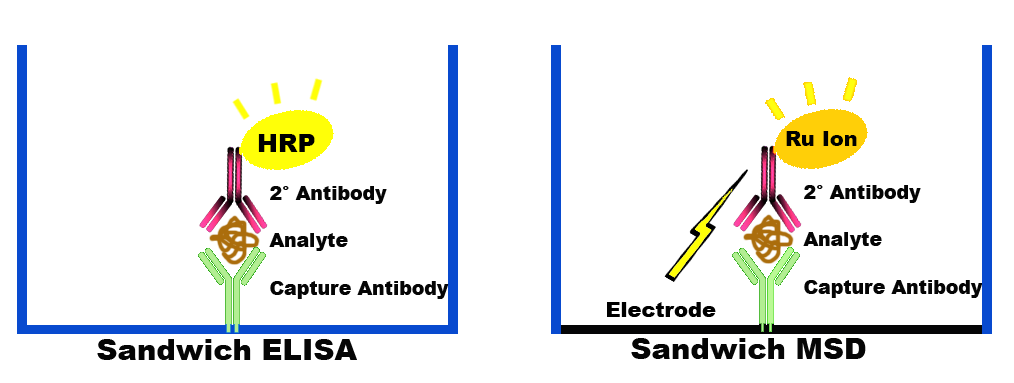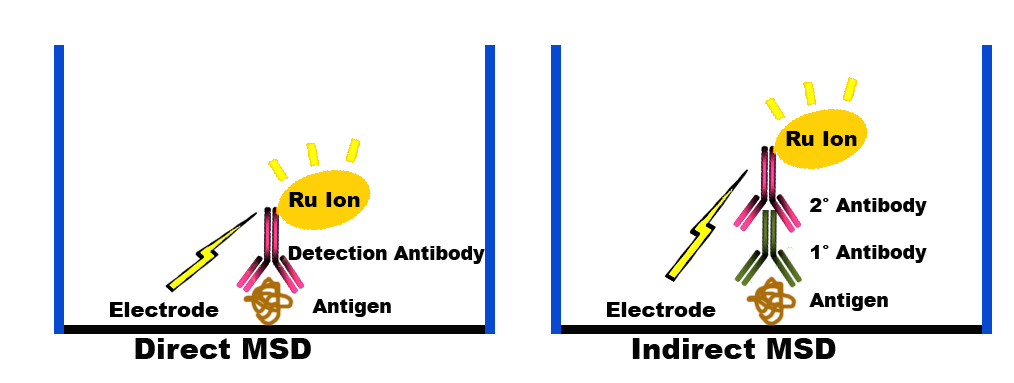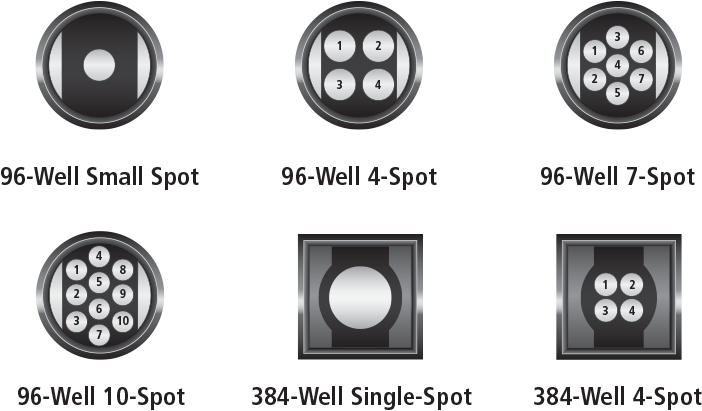MSD (Meso Scale Discovery) is a method similar to ELISA except MSD uses electrochemiluminescence (ECL) as a detection technique as opposed to a colormetric reaction employed by ELISA. An ECL system such as the Meso Scale Discovery platform has many advantages over a traditional ELISA system such as:
- Higher Sensitivity

Improved sensitivity and dynamic range can be achieved by using the MSD platform. - Better Dynamic Range
- Less Matrix Effects
- Ability to Multiplex
- Ability to Scale Up
- Less Sample Required
- Better Efficiencies
MSD Techniques
Just like ELISA there are many assay variations that are possible with MSD. A common ELISA assay is the sandwich ELISA in which the wells on the ELISA plate are coated with a capture antibody then an antigen is added followed by a secondary antibody which is conjugated with an enzyme (such as horseradish peroxidase). The conjugated enzyme can create a colorimetric reaction when exposed to a chemical substrate. The amount of antigen present is directly correlated to the intensity of the color change. A similar scenario could be used in an MSD assay, but several key differences exists that allow the dynamic range and sensitivity to be improved.

When performing a sandwich style MSD assay, the capture antibody is attached to the bottom of the well, but the bottom of an MSD well contains an electrode rather than plastic. Also, the secondary antibody is linked to a ruthenium (Ru) metal ion. If the secondary antibody binds the antigen, the ruthenium ion will be in close enough proximity to the electrode to trigger an oxidation-reduction reaction that will ultimately produce light which can be detected by a CCD camera.
Other common modalities of ELISA are the direct, indirect and bridging assays. All of these techniques can also be used on the Meso Scale Discovery platform. For direct assays, the antigen is bound to the electrode and a primary antibody bound to the Ru metal ion is used to detect the presence of the antigen. Indirect assays are similar in that the antigen is bound to the electrode but a secondary antibody is used that binds to the primary antibody. Bridging assays are commonly conducted when the molecule of interest is another antibody, for example when it is necessary to determine if a patient is producing antibodies against a therapeutic antibody or an antibody drug conjugate (see MSD applications for immunogenicity below). Bridging assays for these types of immunogenicity studies require the therapeutic antibody to be bound to the plate, either directly or via a biotin streptavidin interaction. If antibodies produced by the patient are able to bind to the therapeutic antibody a bridge will occur between the therapeutic antibody bound to the electrode, the patient’s antibody and the the detection antibody which consists of the therapeutic antibody attached to the Ru metal ion.

Multiplexing Using the MSD Platform
The ability to analyze many different analytes within the same well, or multiplexing, is one of the many advantages of the Meso Scale Discovery platform over traditional ELISA. Because light is produced from a molecule that is physically attached to the plate at a specific location different capture antibodies can be placed at different locations within a single well. The CCD camera within the MSD instrument is able to identify up to ten different locations within a single well allowing up to ten different analytes to be quantitated simultaneously using the same sample.
There are many advantages to multiplexing. First it is the most efficient way to analyze multiple molecules from a single sample. Using multiplexing, a single MSD plate can replace up to 10 traditional ELISA plates. In addition, MSD using multiplexing for analyzing a panel of ten analytes will require 50 fold less sample than an ELISA method would. The efficiency improvements and smaller sample amounts have caused many companies to switch to MSD multiplexing to analyze clinical samples.

MSD has several different multiplexing products. V-Plex (V for Validated) products are multiplexing kits that contain validated plates produced by MSD with capture antibodies attached to the plate. U-Plex (U for you do the multiplexing) products allows the user to design their own multiplexing panels by choosing primary antibodies that might not be available in from the V-Plex line of products. For more information regarding multiplexing including a list of available panels and antibody combination, please see our Multiplexing Page.
Comparison of MSD and ELISA
| ELISA | MSD | |
| Sample volume requirement | 50–100 μL (per analyte) | 10–25 μL (up to 10 analytes) |
| Multiplex panels | No | 10 analytes simultaneously |
| Flexible panel configuration | No | Yes (U-PLEX) |
| Dynamic range | 1–2 logs | 3–4+ logs |
| Matrix effects | Yes | Greatly reduced |
| Simple protocols | No | Yes |
| Wash steps | Many | Typically 1–3 |
| Read times | Slow | Up to 960 results in 1 to 3 min |
| Rapid throughput | No | Yes |
| Instrument maintenance | Daily cleaning and calibration | No user maintenance required |
MSD Applications
- MSD used for Immunogenicity Assays and Nab Assays
- MSD used for Cell Based Assays
- MSD used for Biomarker Analysis
- MSD used for PK and PD studies
- MSD for Product Development and Release Testing
- MSD to Assess Toxic Affects
MSD at Pacific BioLabs
Pacific Biolabs can perform GLP, cGMP or R&D Meso Scale Discovery assays using a QuickPlex SQ 120 MSD instrument. Please see PBL’s MSD testing page for more information on how PBL can help develop, validate and perform a MSD assay based on your needs.
